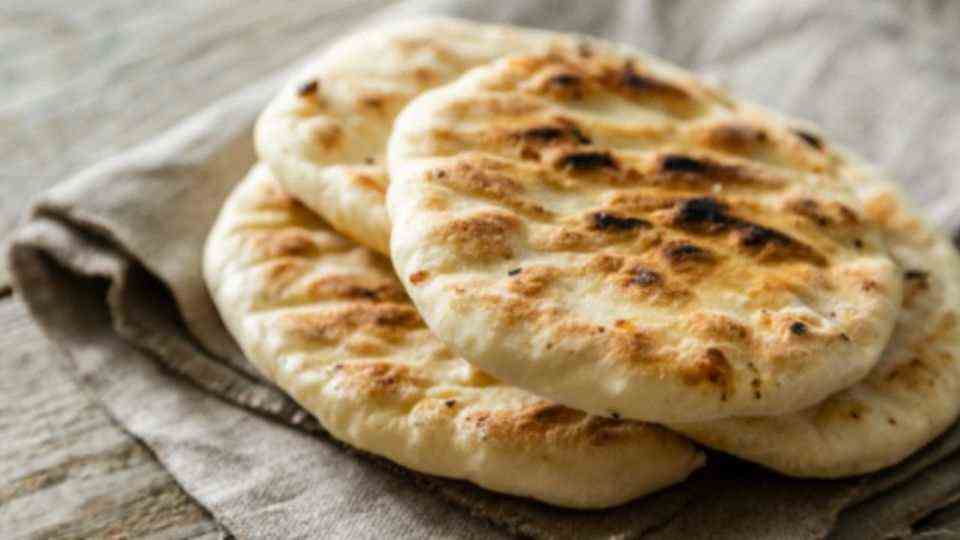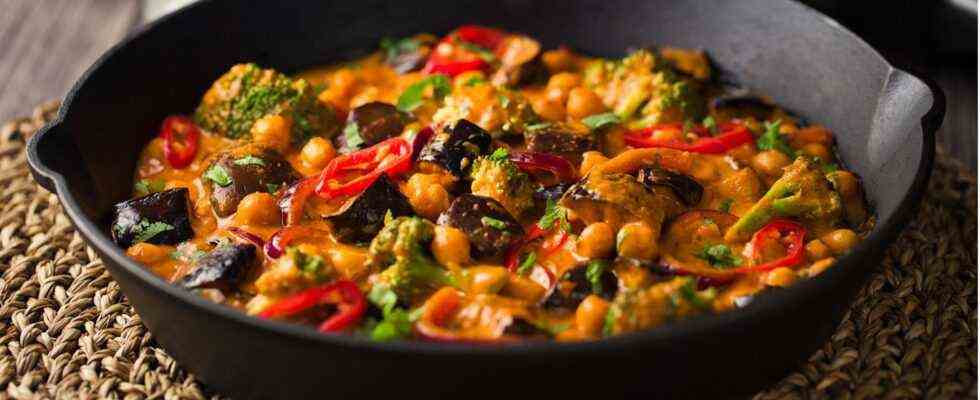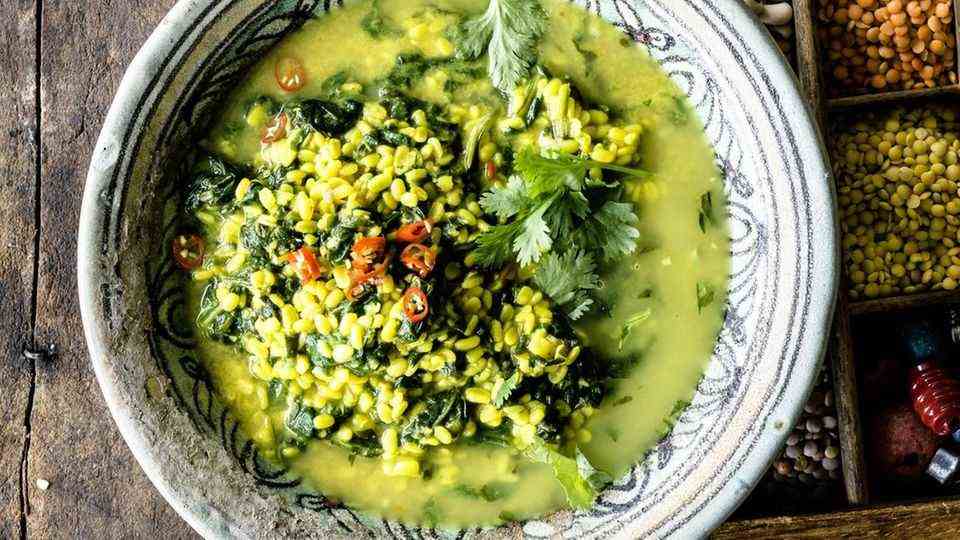Indian cuisine is a feast for the taste buds. No other country offers such a wide range of spices, flavors and cooking styles. Vegan Tikka Masala with aubergines takes you on a culinary journey to the land of contrasts.
On cold autumn days, travel to the land of colors and spices with this vegan eggplant tikka masala. More precisely, it goes to South India: The kitchen in Chettinad, a region in Tamil Nadu in southern India, is known for its vegetarian and vegan dishes. The inhabitants have been importing numerous spices from Burma, Nepal and Southeast Asia since the 18th century. Since then, the regional cuisine has been shaped by the influences of the respective national kitchens.
What does “Tikka Masala” mean?
In its original form, “Tikka” is an Indian curry dish with marinated pieces of meat that are baked in the oven before the curry is cooked. “Masala”, on the other hand, is used to describe various spice mixtures used in Indian cuisine. The Hindu word can be translated as “ingredients” or “spices”. Masala is known as an ingredient in the names of popular Indian spice mixtures – for example “Garam Masala”, “Chat Masala” or “Tandoori Masala”. The term is also used in naming Indian tea blends such as “Chai Masala”.
“Chicken Tikka Masala”: A British national dish
This vegan recipe is based on the popular dish “Tikka Masala”, better known as “Chicken Tikka Masala”. Contrary to what was suspected, however, this does not come from India, but from Great Britain and was created here as part of the British-Indian fusion cuisine. The dish is very popular on the island and is available in almost every restaurant or pub – no wonder it is even counted among the British national dishes.
The exact origin of the dish can be found in the UK after the war. Here the food was developed to harmonize Indian food with English eating habits. A wide variety of myths circulate about the time and place of origin of the dish.
According to a popular version, it originated when an Indian cook served the traditional chicken tikka, or grilled pieces of marinated chicken, to an English guest. Since gravy, a kind of gravy, is generally served with meat in English cuisine, the guest found the dish too dry. The Indian cook had no choice but to improvise a sauce made from tomato soup and Indian spices. What is really true about this story will probably never be finally clarified – in any case, Tikka Masala has enjoyed great popularity since then, regardless of whether in England, India or in numerous other countries around the world.
Indian cuisine: a festival of spices
Tikka Masala tastes very spicy, but not hot. The aroma is primarily determined by coriander. Typical spices of Indian cuisine – especially cumin, ginger and cinnamon – round off the taste. Rice or naan bread are typically served as a side dish to the dish.
Indian cuisine is one thing above all: versatile. India is one of the largest countries in the world, here numerous cultures and tastes meet, geographical and climatic conditions contribute to the diversity of the dishes. In addition, cultural and religious influencing factors play a major role. In Hinduism, for example, the consumption of vegetarian dishes is particularly widespread. Due to the sacred nature of the cow, beef is an absolute taboo. Chicken meat, on the other hand, enjoys great popularity in all walks of life, regardless of religion.
Indian cuisine can be roughly divided into the four cardinal directions. The North Indian cuisine, which is most common in Europe, is characterized by dishes from the clay oven. Famous examples are the tandoori chicken or the classic naan bread. In addition, a relatively large number of dairy products are processed in the north: In addition to ghee, a well-known Indian clarified butter, yogurt is a favorite with dishes.
In the south, on the other hand, rice is mainly consumed instead of wheat, often in combination with very hot, vegetarian curries or processed into rice pancakes. In the west and east of India, on the contrary, fish and shellfish are regularly on the menu.
However, the basic components of the various national kitchens are similar: in addition to rice and cereals, legumes in particular are used. But India is particularly known for its spice blends. Fenugreek seeds, turmeric, curry leaves, cumin, fennel seeds, cloves, nutmeg, cinnamon, ginger, chilli, coriander and cardamom give dishes their typical aroma, but are not only of immense importance for dishes, but also for drinks such as the popular chai tea .
Indian cuisine categorizes six tastes: sweet, sour, salty, spicy, bitter and astringent. A meal in India is considered balanced when all of these tastes are part of the meal – a difficult goal to achieve.
Vegan enjoyment
We achieve the basic note of the vegan eggplant Tikka Masala by adding the typical Tikka Masala paste: Spices such as turmeric, paprika powder, cayenne pepper, cumin and cinnamon provide the right flavor. Fresh ginger, garlic and coriander complete this and, together with tomato paste and desiccated coconut, provide the typical Tikka Masala taste.
Instead of chicken, however, the eggplant is now used. Their meat-like consistency is an excellent vegetable alternative. As the nightshade plant contains a lot of liquid, it should be salted beforehand and left to stand for a short time. So it loses most of its fluid. In the pan, the aubergine does not cook in its own juice, it absorbs less fat and has a milder aroma and a softer consistency. Together with zucchini, chickpeas and a wonderfully creamy sauce, a very special taste ensemble is created.
The Tikka Masala is served with rice or fresh naan bread.
Recipe for a vegan eggplant tikka masala
ingredients
- 800 grams of eggplant
- 2 cloves of garlic
- 1 thumb-sized piece of ginger
- 1 dried chilli pepper
- 2 tablespoons of paprika hot pink
- 2 teaspoons of cayenne pepper
- 1 teaspoon sea salt
- a pinch of nutmeg
- 0.5 teaspoon turmeric
- 0.5 teaspoon anise
- 1 teaspoon Ceylon cinnamon
- 0.5 teaspoon of ground cardamom
- 1.5 teaspoons of ground cumin
- some pepper
- 2 tablespoons desiccated coconut
- 2 tablespoons of ground almonds
- 4 tablespoons of tomato paste
- 4 tablespoons of peanut oil
- 1 handful of fresh coriander
- 1 medium zucchini
- 1 onion
- 2 cans of coconut milk (2 times 400 milliliters)
- 1 can of chickpeas (400 grams)
- 300 grams of rice, dry weight (alternative: fresh naan bread)
- salt and pepper
- some coriander for garnish

preparation
- Wash the eggplant, cut in half and cut into cubes. Add a little salt and let it steep, so the vegetables lose water.
- Peel the garlic and ginger and cut into small pieces, chop the chilli pepper and mix everything together in a bowl.
- Add the spices, desiccated coconut, ground almonds, tomato paste and peanut oil and stir until a creamy mixture is obtained.
- Wash the fresh coriander, shake it dry, pluck the fine leaves and chop. Also add to the paste and mix.
- Chop the zucchini and onions and sauté in the wok. Add the paste and lightly toast. Deglaze with the coconut milk. Add the chickpeas and simmer gently.
- In the meantime, put on a saucepan with water and bring to the boil. Cook the rice according to the instructions.
- Drain the leaked water from the aubergines and fry the aubergines in a separate pan. As soon as the aubergine is slightly brown, add it to the other ingredients.
- Season to taste with a little salt and pepper and serve with rice or fresh naan bread and a little coriander.


